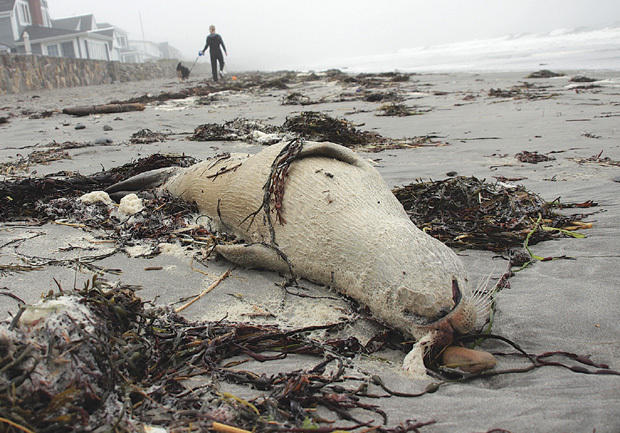Bird flu blamed for deaths of New England seals: Can H3N8 strain spread to humans?
(CBS News) A new strain of bird flu that has killed seals off the New England coast has scientists worried over the potential risk of the virus spreading to humans.
Bird flu, or avian influenza, typically is only spread between birds, however people who come into close contact with infected poultry may develop the disease. Farmers who work with poultry, people who eat meat, eggs or blood from infected birds and people who touch an infected bird may develop the disease. The first case of avian flu found in humans occurred in 1997 in Hong Kong, which was found to be the H5N1 strain.
First of controversial bird flu papers published
Second of controversial bird flu studies published after terrorism debate
Following the deaths of 162 seals off the coast from southern Maine to northern Mass., over a three-month period beginning in September 2011, scientists identified a new strain of avian H3N8 virus as the culprit. Their findings are published in the July 31 issue of the American Society for Microbiology's journal, mBio.
The seals displayed signs of severe pneumonia and skin lesions. Most of those infected were younger than 6 months old.
"When initial tests revealed an avian influenza virus, we asked the obvious question: how did this virus jump from birds to seals?" study author Simon Anthony, a postdoctoral research scientist at the Center for Infection and Immunity at Columbia University's Mailman School of Public Health, said in a press release.
Further analysis and sequencing of the strain's genetic makeup led researchers to conclude that H3N8 in seals came from a bird flu strain that has been found in North American waterfowl since 2002. That suggests the strain recently became able to transmit from wild birds to seals. The researchers identified 37 mutations in the seal strain of the virus that differentiated it from that of birds. Superficially, this strain of H3N8 has been able to bind to receptors found in a mammal's respiratory tract through mutations in two genes that control for cell entry and replication, which suggest an enhanced route of disease transmission in mammals.
Given those findings and the historical transmission of bird flu strains to humans, seal H3N8 could potentially pose a threat to public health, the researchers warned.
"HIV/AIDS, SARS, West Nile, Nipah and influenza are all examples of emerging infectious diseases that originated in animals," W. Ian Lipkin, director of the Center for Infection and Immunity at Columbia, said in the press release. "Any outbreak of disease in domestic animals or wildlife, while an immediate threat to wildlife conservation, must also be considered potentially hazardous to humans."
The National Oceanic and Atmospheric Administration first reported on the H3N8 strain in seals in December 2011, at the time telling people and pets to stay at least 150 feet away from a sickened seal.
Bird flu has been in the spotlight this year because of two controversial research papers that describe strains of the virus that researchers created that could potentially be transmitted through the air to humans. U.S. biosecurity officials asked researchers not to publish details of their work, fearing terrorists could use it to make a biological weapon.
Both papers were eventually published in the journal, Science.
Eddie Holmes, an influenza expert at Penn State University who was not involved in the new study, commended the research for the New York Times, but added the new strain needs to be carefully monitored to see if it poses a threat.
"The question mark is what it means for seals, and what it means for us," Holmes said.

